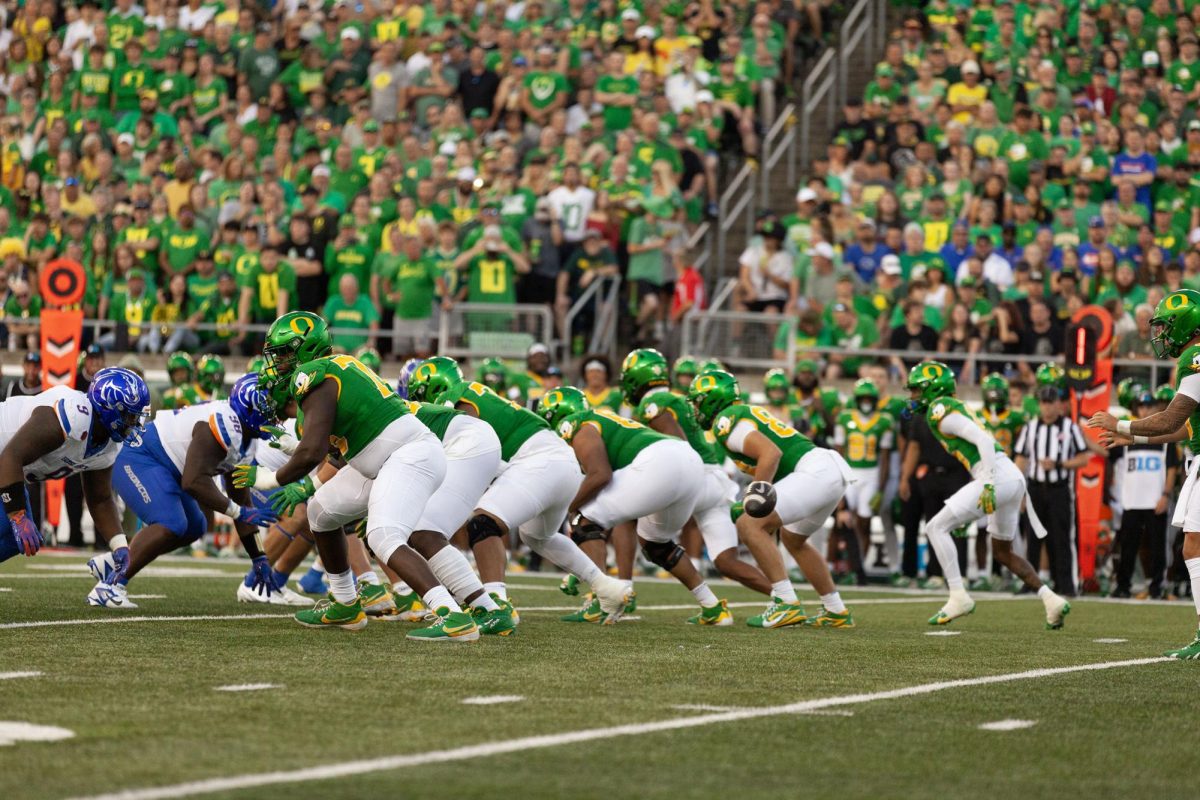After Week 1’s narrow 24-14 victory against Idaho, head coach Dan Lanning noted the team’s need to create more “explosive plays.”
While the Ducks did exactly that in a barn-burning 37-34 win, they failed to work any long-winded offensive drives to tire out the defense.
Oregon attained most of its offensive yardage through “chunk plays” (plays that go for 30 yards or more). The situation created by that made it significantly harder for the Ducks to convert plays within five yards of the first down marker — especially third downs.
Oregon converted just one of its six third down attempts in the first half — a number which improved slightly by the end of the game, as the Ducks converted four of their 12 third down attempts.
Many of those chunk plays came via improvisation by running back Jordan James, as the passing offense struggled mightily for the first half of the game. Even when Dillon Gabriel found success, it only came from throws over 30 yards downfield.
For example, Oregon’s second touchdown of the game came by way of a 34-yard bomb to Evan Stewart.
“I think our coaching staff did a good job of recognizing when we’d have [explosive play] opportunities…We told ourselves early on that we’re gonna take a shot down the field, and Evan really capitalized on that pass,” Lanning said.
Early in the third quarter, Gabriel managed to find Traeshon Holden on third-and-8 over the middle through a chaotic sea of pass rushers. In what seemed like the first short completion for positive yards, Oregon tied the game at 20.
“I think we had a lot of shots called…We gained confidence creating windows in isolation for our receivers…it’s a good time,” Gabriel said.
However, it often felt like the Ducks waited until third down to even attempt passes at all. Which was shocking considering up until the fourth quarter, the Ducks accrued more penalty yards than rushing yards.
With just over three minutes left in the third, the Ducks were again aided by an electric, explosive play — this time from Tez Johnson.
Johnson picked up a punt, quickly broke off the first tackler and saw his daylight. Eighty-five yards later, Johnson stomped into the endzone and the Ducks took their third lead of the night.
That is the type of explosive play that Lanning wanted.
“I told myself when I walked out there ‘I’m gonna be aggressive,’ just be aggressive, and as soon as I caught the ball, I was like ‘here we go,’” Johnson said.
Mistakes came back to bite the Ducks, however.
Oregon coughed up two fumbles and put the ball in the hands of Boise State’s electric running back Ashton Jeanty, leading to 14 unanswered points for the Broncos. Oregon’s defense found itself equally susceptible to explosive plays.
“We knew mistakes were gonna happen on both sides of the ball, but how fast can you move on to the next play and execute the next play?” Johnson said.
The next play for the Ducks proved another huge moment, as it might have saved Oregon in Saturday’s contest.
After falling behind 34-27, Noah Whittington returned the ensuing kickoff 100 yards to the house — tying the game. Whittington dropped the ball just before he reached the goal line, but it got scooped up by teammate Jayden Limar, so he was credited with the score.
Once again, Oregon’s big play ability shined at the perfect moment, and it became a primary turning point in this game. Boise State did not score after this, while the Ducks pounced on their opportunity and won the game as time expired.
It wasn’t pretty and it included a lot of stress, but the job got done. It just so happened that the mechanism by which it got done was the same exact problem that Lanning pointed out after Week 1.







